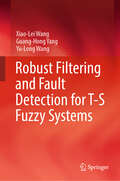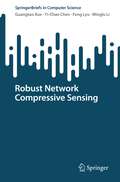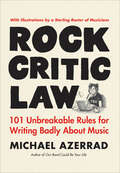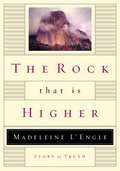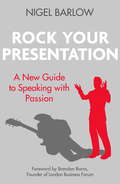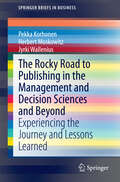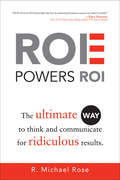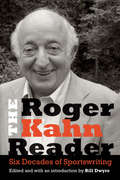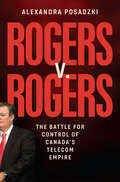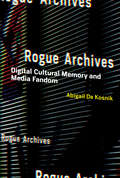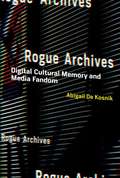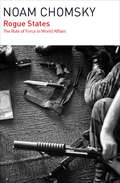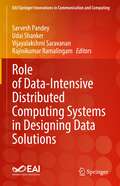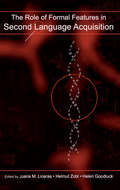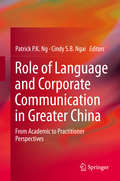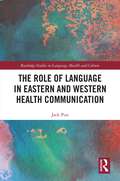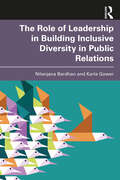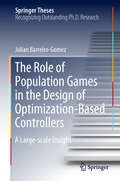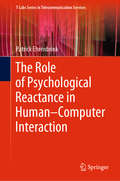- Table View
- List View
Robust Filtering and Fault Detection for T-S Fuzzy Systems
by Xiao-Lei Wang Guang-Hong Yang Yu-Long WangThis book conducts an in-depth research on robust filtering and fault detection for a class of T-S fuzzy systems. On the basis of the existing research on T-S fuzzy theory, robust filtering theory, and fault diagnosis theory, some new and effective technologies are proposed to solve the problems of robust filtering and fault detection for a class T-S fuzzy systems, while overcoming the shortcomings and limitations of the existing solutions. This book introduces new design solutions for a class of T-S fuzzy systems to address the existing problems in the research of robust filtering and fault detection, namely 1) two new filtering methods are explored to obtain better filtering results than the existing approaches; 2) a new event-triggered filtering scheme is proposed for T-S fuzzy systems with bounded disturbances, which realizes that the designed observer gains in the absence of event-triggered mechanisms are also applicable to the case with event-triggered mechanisms; 3) two new methods are constructed to deal with the asynchronous problems of premise variables effectively, which overcome the defects and limitations of the existing ones; and 4) an effective fault detection scheme for handling measurement outliers is constructed, which can avoid the occurrence of false alarms. This book is intended to inspire researchers and engineers, offering deeper insights into robust filtering and fault detection for T-S fuzzy systems, and equipping them with the latest advancements in fuzzy system theory, robust filtering, and fault diagnosis. It also provides valuable theoretical references for engineers tackling practical engineering problems.
Robust Network Compressive Sensing (SpringerBriefs in Computer Science)
by Guangtao Xue Yi-Chao Chen Feng Lyu Minglu LiThis book investigates compressive sensing techniques to provide a robust and general framework for network data analytics. The goal is to introduce a compressive sensing framework for missing data interpolation, anomaly detection, data segmentation and activity recognition, and to demonstrate its benefits. Chapter 1 introduces compressive sensing, including its definition, limitation, and how it supports different network analysis applications. Chapter 2 demonstrates the feasibility of compressive sensing in network analytics, the authors we apply it to detect anomalies in the customer care call dataset from a Tier 1 ISP in the United States. A regression-based model is applied to find the relationship between calls and events. The authors illustrate that compressive sensing is effective in identifying important factors and can leverage the low-rank structure and temporal stability to improve the detection accuracy. Chapter 3 discusses that there are several challenges in applying compressive sensing to real-world data. Understanding the reasons behind the challenges is important for designing methods and mitigating their impact. The authors analyze a wide range of real-world traces. The analysis demonstrates that there are different factors that contribute to the violation of the low-rank property in real data. In particular, the authors find that (1) noise, errors, and anomalies, and (2) asynchrony in the time and frequency domains lead to network-induced ambiguity and can easily cause low-rank matrices to become higher-ranked. To address the problem of noise, errors and anomalies in Chap. 4, the authors propose a robust compressive sensing technique. It explicitly accounts for anomalies by decomposing real-world data represented in matrix form into a low-rank matrix, a sparse anomaly matrix, an error term and a small noise matrix. Chapter 5 addresses the problem of lack of synchronization, and the authors propose a data-driven synchronization algorithm. It can eliminate misalignment while taking into account the heterogeneity of real-world data in both time and frequency domains. The data-driven synchronization can be applied to any compressive sensing technique and is general to any real-world data. The authors illustrates that the combination of the two techniques can reduce the ranks of real-world data, improve the effectiveness of compressive sensing and have a wide range of applications. The networks are constantly generating a wealth of rich and diverse information. This information creates exciting opportunities for network analysis and provides insight into the complex interactions between network entities. However, network analysis often faces the problems of (1) under-constrained, where there is too little data due to feasibility and cost issues in collecting data, or (2) over-constrained, where there is too much data, so the analysis becomes unscalable. Compressive sensing is an effective technique to solve both problems. It utilizes the underlying data structure for analysis. Specifically, to solve the under-constrained problem, compressive sensing technologies can be applied to reconstruct the missing elements or predict the future data. Also, to solve the over-constraint problem, compressive sensing technologies can be applied to identify significant elementsTo support compressive sensing in network data analysis, a robust and general framework is needed to support diverse applications. Yet this can be challenging for real-world data where noise, anomalies and lack of synchronization are common. First, the number of unknowns for network analysis can be much larger than the number of measurements. For example, traffic engineering requires knowing the complete traffic matrix between all source and destination pairs, in order to properly configure traffic and avoid congestion. However, measuring the flow between all source and destination pairs is very expensive or even infeasible. Reconstructing data from a small number of measurements is an underconstrained proble
Rock Critic Law: 101 Unbreakable Rules for Writing Badly About Music
by Michael AzerradStraight out of his beloved Twitter feed @RockCriticLaw, acclaimed rock journalist and author of the classic books Come As You Are: The Story of Nirvana and Our Band Could Be Your Life, Michael Azerrad turns his trenchant eye to the art of rock writing itself, hilariously skewering 101 of the genre’s seemingly endless litany of hackneyed phrases and tropes.One of the finest music writers today, Michael Azerrad has catalogued the shortcuts, lazy metaphors and uninspired prose that so many of his beloved colleagues all too regularly rely on to fill column inches. In 2014, he began his wickedly droll Twitter feed @RockCriticLaw to expose and make fun of this word-hash. Now, he consolidates these "Laws" into one witty, comprehensive and fully illustrated volume.Rock Critic Law includes timeless gems such as:If a band pioneered something, you must say they are "seminal." That is the Seminal Law of Rock Criticism.If a recording features densely layered guitars, then you MUST use the phrase "sonic cathedrals."Even when it’s easy to find out with research, by all means ask a band how they got their name.Please feel free to deny an artist’s individuality and say they are "the new [x]."If two guitars play a melodic line in harmony, you MUST say they are "twin lead guitars."All 101 Rock Critic Laws are accompanied by original illustrations from Ed Fotheringham, beloved Seattle scenester and highly regarded artist who has created album covers for everyone from, well, seminal grunge band Mudhoney to iconic jazz label Verve Records, as well as illustrations for TheAtlantic, Vanity Fair, The New Yorker and more, making this book a must-have for music lovers everywhere. A unique appreciation of music writing from one of its own, Rock Critic Law irreverently captures all the passion and furor of fandom.
The Rock That Is Higher: Story As Truth
by Madeleine L'Engle"We are all strangers in a strange land, longing for home, but not quite knowing what or where home is. We glimpse it sometimes in our dreams, or as we turn a corner, and suddenly there is a strange, sweet familiarity that vanishes almost as soon as it comes Madeleine L Engle, from "The Rock That Is Higher Story captures our hearts and feeds our imaginations. It reminds us who we are and where we came from. Story gives meaning and direction to our lives as we learn to see it as an affirmation of God s love and truth an acknowledgment of our longing for a rock in the midst of life s wilderness. Drawing upon her own experiences, well-known tales in literature, and selected narratives from Scripture, Madeleine L Engle gently leads the way into the glorious world of story in "The Rock That Is Higher. " Here she acknowledges universal human longings and considers how literature, Scripture, personal stories, and life experiences all point us toward our true home. "
Rock the Tech Stage: How the Best Speakers in Tech Present Ideas and Pitch Products
by Oscar SantolallaThis book unveils ten secrets on how to masterfully speak in the technology arena. It is primarily based on stories from entrepreneurs, executives and engineers from technology companies that have shaped history: Steve Jobs, Tim Cook, Elon Musk, Jim Grubb (Cisco), Mikko Hyppönen (F-secure), Jane Chen (Embrace Innovations) and many more. Most of them have appeared on the stages of large conferences and events presenting their products and inventions. Today the technology arena is more dynamic and innovating than ever: mobile applications, cloud services, artificial intelligence, clean technologies, blockchain, etc.There are increasingly more spaces to share knowledge and promote products. Both aspects make speaking about technology harder than ever: how should you speak about your product or company in a way that your audience not only gets what you say but gets inspired enough to become followers?The ten practices presented in this book are: story, demo, metaphor, data visualization, passion, props, presentation hacks, interaction, staging, and memory. All core aspects that a technical person needs to rock the stage at conferences. What You Will LearnA wide range of skills which will help you make a solid and persuasive presentation or talkHow to craft compelling storiesHow to write better (blogs and copy) about technical products and eventsWho This Book is ForDevOps, developer evangelists, testers, architects, product managers, sales engineers, solution architects, CTOs, CEOs, startup founders, marketers
Rock Your Presentation: A New Guide to Speaking with Passion
by Nigel BarlowThis book will protect your audiences from the following disorders:· Death by PowerPoint· Tedium· Compulsive fidgeting· Losing-the-Will-to-Live SyndromeNearly all of us have to pitch or present our ideas, whether in a formal setting like a theatre, at a company conference, in a classroom or even selling a concept one-to-one to our boss. In Rock your Presentation, Nigel Barlow, a professional keynote speaker and creative coach to many of the world's most famous organisations, gives you inspiring insights and practical techniques to 'rock up' your presentation or speech. Many of these tips come from exploring what makes great music so moving and impactful, and are easy to apply to make your own talks more dynamic and memorable. Try changing your key for different emotional impact; come up with a stronger chorus and an exciting climax; create your speaker's rider; be a protest singer to unleash your passion; and learn when and how to go unplugged to touch your audience. Whether you want to create a whole new presentation or tune up a tired old one, Rock Your Presentation will give you plenty of fresh ideas.
Rock Your Presentation: A New Guide to Speaking with Passion
by Nigel BarlowNearly all of us have to pitch or present our ideas, whether in a formal setting after lunch to a hundred jaded salespeople, in a lecture theatre or classroom, putting over our thoughts to a team of colleagues, or even selling a concept one-on-one to your boss.In all these situations we can choose between delivering a message that sounds like muzak, or one that wakes the listener up. Most presentations and pitches could benefit from being 'rocked up' - becoming more dynamic and memorable, in ways that arouse the passion of the audience. By applying the ideas in ROCK YOUR PRESENTATION you can deliver better, livelier and more emotionally engaging talks which leave audiences with the kind of high you get from being in a crowd at a great concert.Barlow applies the rock'n'roll metaphor throughout the book, turning what, to many, is a stressful subject into an exciting and fun exercise you can't wait to try out. So take the Van Halen approach to planning your presentation, deliver it like a hit song with a chorus and a bridge, play a few well-rehearsed power chords and set your audience ablaze.
Rocket-Triggered Lightning: The Development of Physical Process and Effect of Lightning Discharge
by Mi Zhou Jianguo Wang Li Cai Jinxin Cao Yadong FanThis book summarises the fruitful results of rocket-triggered lightning experiments conducted in Guangdong, China, in recent years, including data analysis and theoretical research. One of the main features of this book is to compare the differences between lightning strikes on overhead power lines and strikes on the ground. Starting from the technical background and experimental methods of rocket-triggered lightning, the book delves into the electric current, electric field, magnetic field, optical and acoustic characteristics of artificially triggered lightning. Proceeding progressively from basic to advanced levels, this book meets the needs of scientists at different levels of expertise. It will benefit researchers, engineers and graduate students working in the fields of lightning detection, lightning physics and lightning protection.
The Rocky Road to Publishing in the Management and Decision Sciences and Beyond
by Pekka Korhonen Herbert Moskowitz Jyrki WalleniusThis book documents the history of two research papers, from the first drafts to the final polished published articles, including the reviewer comments and the author responses. The documentary provides unique insights into the publishing process, which at times is filled with uncertainties, not only for young researchers. The book discusses lessons learned and also provides an experienced editor's and reviewer's perspective. In the light of the high pressure on young faculty to publish successfully, this book offers itself as a guide to publishing efficiently and effectively in a highly competitive scientific environment.
ROE Powers ROI: The Ultimate Way to Think and Communicate for Ridiculous Results (Roe Powers Roi Ser.)
by R. Michael RoseA common sense guide to thinking and communication styles that will help readers improve business performance.Business is complicated even in the best of times. We are not in the best of times, and it’s more complicated than ever. ROE Powers ROI de-complicates business and provides for clear insight at every level of its organization.As a business owners, consultant, and advisor, Michael has had the advantage of observing both successful and failed businesses and comparing results from the experience. He brings his own empirical, science-based approach to simplify business utilizing the ROE Methodology. ROE, or Return on EnergyTM, was developed to get the right people into the right seats and maximize your organization’s success, or return on investment.Michael’s ability to bring clarity to complex business jargon is so powerful that it serves well as a foundational tool to better understand and process business today.Praise for ROE Powers ROI“Provides the key to ensuring business success in today’s world.” —Vince Poscente, New York Times–bestselling author of The Age of Speed“A new and important contribution to business and management literature. It lays out a compelling vision for how a CEO can get the best and most collaborative outcomes from the management team.” —Charles D. Connor; President and CEO, American Lung Association“Innovative, invigorating, and right-on, Michael Rose’s ROE Powers ROI will enhance the way you think forever. This book should come with a highlighter. Read, reread, and progress.” —Dean Lindsay, author of The Progress Challenge and Creating Progress in a World of Change
The Roger Kahn Reader: Six Decades of Sportswriting
by Roger Kahn Bill DwyreMost famous for his classic work The Boys of Summer, Roger Kahn is widely regarded as one of the greatest sportswriters of our time. The Roger Kahn Reader is a rich collection of his stories and articles that originally appeared in publications such as Sports Illustrated, theNew York Times, Esquire, and the Nation. Kahn’s pieces, published between 1952 and today, present a vivid, turbulent, and intimate picture of more than half a century in American sport. His standout writings bring us close to entrepreneurs and hustlers (Walter O'Malley and Don King), athletes of Olympian gifts (Ted Williams, Stan Musial, “Le Demon Blond” Guy Lefleur), and sundry compelling issues of money, muscle, and myth. We witness Roger Maris’s ordeal by fame; Bob Gibson’s blazing competitive fire; and Red Smith, now white-haired and renowned, contemplating his beginnings and his future. Also included is a new and original chapter, “Clem,” about the author’s compelling lifelong friendship with former Brooklyn Dodgers pitcher Clem Labine. Written across six decades, this volume shows Kahn’s ability to describe the athletes he profiled as they truly were in a manner neither compromised nor cruel but always authentic and up close.
Roger, Sausage and Whippet: A Miscellany of Trench Lingo from the Great War
by Christopher MooreRoger: A code word for a gas cylinder and a nickname for rum. Sausage: An observation balloon. Whippet: A small, light type of tank with a top sped of eight m.p.h. The First World War raged for four years, taking with it hundreds of thousands of young soldiers who lived and died together, bonded by the horror of the war. Now, all the way from the trenches and through the letters of Christopher Moore's Captain Cartwright, comes an extraordinary lexicon of the phrases and lingo of life at the front. Whether born from the desperation of gallows humour ('If it keeps on like this, someone's going to get hurt'), borrowed from Cockney rhyming slang, Latin, French and other languages ('Cushy: Comfortable, safe, pleasant. From the Hindustani: khush, pleasure') or even taken from the name of the Huntley and Palmer biscuit company, Tommy had a new word for almost everything. From Ammo to Zig-Zag, this is a fascinating glimpse into the world of our First World War heroes. So fetch the dooly and the other makings, brew up some char, and read on safe in the knowledge that you won't be going over the top today...
Rogers v. Rogers: The Battle for Control of Canada's Telecom Empire
by Alexandra PosadzkiA riveting, deeply reported account that takes us inside the dramatic battle for control of Canada&’s largest wireless carrier, and paints a broader picture of the cutthroat telecom industry, the labyrinth of regulatory and political systems that govern it, and the high-stakes corporate games played by the Canadian establishment. Alexandra Posadzki&’s ground-breaking coverage in the Globe and Mail exposed one of the most spectacular boardroom and family dramas in Canadian corporate history—one that has pitted the company&’s extraordinarily powerful chairman and controlling shareholder, Edward Rogers, against not only his own management team but also the wishes of his mother and two of his sisters. Hanging in the balance is no less than the pending $20 billion acquisition of Shaw Communications, a historic deal that promises to transform Rogers into the truly national telecom empire that its late founder, Ted Rogers, always envisioned. Based on deeply sourced, investigative reporting of the iconic $30 billion publicly traded telecom and media giant, Posadzki takes us inside a company that touches the lives of millions of Canadians, challenging what we thought we knew about corporate governance and who really holds the power. Rogers v. Rogers is also a story of family legacy and succession, of an old guard pushing back at the new guard, and of a company struggling to find its footing in the wake of its legendary founder&’s death. At the heart of it all is a dispute between warring factions of the family over how they each interpret the desires of the late patriarch and the very identity of the company that bears their name.
Rogue Archives: Digital Cultural Memory and Media Fandom
by Abigail De KosnikAn examination of how nonprofessional archivists, especially media fans, practice cultural preservation on the Internet and how “digital cultural memory” differs radically from print-era archiving.The task of archiving was once entrusted only to museums, libraries, and other institutions that acted as repositories of culture in material form. But with the rise of digital networked media, a multitude of self-designated archivists—fans, pirates, hackers—have become practitioners of cultural preservation on the Internet. These nonprofessional archivists have democratized cultural memory, building freely accessible online archives of whatever content they consider suitable for digital preservation. In Rogue Archives, Abigail De Kosnik examines the practice of archiving in the transition from print to digital media, looking in particular at Internet fan fiction archives.De Kosnik explains that media users today regard all of mass culture as an archive, from which they can redeploy content for their own creations. Hence, “remix culture” and fan fiction are core genres of digital cultural production. De Kosnik explores, among other things, the anticanonical archiving styles of Internet preservationists; the volunteer labor of online archiving; how fan archives serve women and queer users as cultural resources; archivists' efforts to attract racially and sexually diverse content; and how digital archives adhere to the logics of performance more than the logics of print. She also considers the similarities and differences among free culture, free software, and fan communities, and uses digital humanities tools to quantify and visualize the size, user base, and rate of growth of several online fan archives.
Rogue Archives: Digital Cultural Memory and Media Fandom
by Abigail De KosnikThe task of archiving was once entrusted only to museums, libraries, and other institutions that acted as repositories of culture in material form. But with the rise of digital networked media, a multitude of self-designated archivists -- fans, pirates, hackers -- have become practitioners of cultural preservation on the Internet. These nonprofessional archivists have democratized cultural memory, building freely accessible online archives of whatever content they consider suitable for digital preservation. In Rogue Archives, Abigail De Kosnik examines the practice of archiving in the transition from print to digital media, looking in particular at Internet fan fiction archives.De Kosnik explains that media users today regard all of mass culture as an archive, from which they can redeploy content for their own creations. Hence, "remix culture" and fan fiction are core genres of digital cultural production. De Kosnik explores, among other things, the anticanonical archiving styles of Internet preservationists; the volunteer labor of online archiving; how fan archives serve women and queer users as cultural resources; archivists' efforts to attract racially and sexually diverse content; and how digital archives adhere to the logics of performance more than the logics of print. She also considers the similarities and differences among free culture, free software, and fan communities, and uses digital humanities tools to quantify and visualize the size, user base, and rate of growth of several online fan archives.
Rogue States: The Rule of Force in World Affairs (Chomsky Perspectives Ser. #No. 13)
by Noam ChomskyThe bestselling author and activist &“has delivered another impressive argument that the U.S. flouts international law when it finds it convenient to do so&” (Publishers Weekly). In this still-timely classic, Noam Chomsky argues that the real &“rogue&” states are the United States and its allies. Chomsky turns his penetrating gaze toward US involvement in the Middle East, Southeast Asia, the Caribbean, and Latin America to trace the enduring combined effects of military domination and economic imperialism on these regions. &“Noam Chomsky is like a medic attempting to cure a national epidemic of selective amnesia . . . [Rogue States is] a timely guide to the tactics that the powerful employ to keep power concentrated and people compliant . . . Chomsky&’s work is crucial at a time when our empire perpetually disguises its pursuit of power under the banners of &‘aid,&’ &‘humanitarian intervention,&’ and &‘globalization.&’ Americans have to begin deciphering the rhetoric. Chomsky&’s a good place to start.&” —The Village Voice &“World-famous MIT linguist Chomsky has long kept up a second career as a cogent voice of the hard left, excoriating American imperialism, critiquing blinkered journalists and attacking global economic injustice.&” —Publishers Weekly &“Nothing escapes [Chomsky&’s] attention . . . [Rogue States is] wonderfully lucid.&” —PeaceWork Praise for Noam Chomsky &“Chomsky is a global phenomenon . . . perhaps the most widely read voice on foreign policy on the planet.&” —The New York Times Book Review &“The conscience of the American people.&” —New Statesman &“One of the radical heroes of our age . . . a towering intellect . . . powerful, always provocative.&” —The Guardian
Role Mate to Soul Mate: The Seven Secrets to Lifelong Love
by Warren FarrellNew York Times bestselling author Dr. Warren Farrell reveals solutions to the seven most important barriers to sustaining love—practices that have helped thousands of real couples rediscover their "soul mate" spark. When Dr. Farrell began teaching couples&’ communication 30 years ago, he taught the wisdom of not being defensive in response to criticism. However, when a couple returned home and a criticism inevitably appeared, that wisdom disappeared. Couples needed to not just be taught this, but to practice both in the workshop and at home. With the help of decades of post-workshop feedback from real couples, Farrell perfected six mindsets that the couples found most effective to embrace criticism as an opportunity to feel more deeply loved—even while they are being criticized. Role Mate to Soul Mate guides couples on how to do this for two hours per week as a &“Caring and Sharing Practice.&” For the other 166 hours, couples create a &“Conflict-Free Zone&” the other 166 hours, which requires preventing criticisms from becoming conflicts. To do this, you&’ll learn how to: Appreciate your loved one with five levels of specificity, both creatively and consistently Transform the &“Four Depleters of Love&” (Criticisms, Complaining, Complacency, and Controlling) into ways to deepen love Master the eleven &“Soulmate Wisdoms&” Play together, because &“couples that play together stay together&” Create win-win solutions to your stickiest problems Apply your new skills to family, friends, colleagues—and even political opponents Since falling in love is natural but sustaining love is unnatural, making these skills come naturally requires an evolutionary shift that is both an art and a discipline. The Role Mate to Soul Mate reward? A deeper, dynamic, and lifelong love.
Role of Data-Intensive Distributed Computing Systems in Designing Data Solutions (EAI/Springer Innovations in Communication and Computing)
by Sarvesh Pandey Udai Shanker Vijayalakshmi Saravanan Rajinikumar RamalingamThis book discusses the application of data systems and data-driven infrastructure in existing industrial systems in order to optimize workflow, utilize hidden potential, and make existing systems free from vulnerabilities. The book discusses application of data in the health sector, public transportation, the financial institutions, and in battling natural disasters, among others. Topics include real-time applications in the current big data perspective; improving security in IoT devices; data backup techniques for systems; artificial intelligence-based outlier prediction; machine learning in OpenFlow Network; and application of deep learning in blockchain enabled applications. This book is intended for a variety of readers from professional industries, organizations, and students.
The Role of Formal Features in Second Language Acquisition (Second Language Acquisition Research Series)
by Juana M. Liceras Helmut Zobl Helen GoodluckUsing Chomsky's minimalist program as a framework, this volume explores the role of formal (or functional) features in current descriptions and accounts of language acquistion. In engaging, up-to-date articles, distinguished experts examine the role of features in current versions of generative grammar and in learnibility theory as it relates to native, non-native, and impaired acquisition.
The Role of Henri Borel in Chinese Translation History (Routledge Studies in Chinese Translation)
by Audrey HeijnsAgainst the historical background of Chinese translation in the West and the emergence of several prominent European translators of China, this book examines the role of a translator in terms of cross-cultural communication, the image of the foreign culture in the minds of the target audience, and the influence of their translations on the target culture. With the focus on the career and output of the Dutch translator Henri Borel (1869–1933), this study investigates different aspects of the role of translator. The investigation is carried out by analysing texts and probing the achievements and contributions of the translator, underpinned by documents from the National Archives and the Literature Museum in the Hague, the Netherlands. Based on the findings derived from this study, advice is offered to those now involved in the promotion and translation of Chinese culture and literature. It will make an important contribution to the burgeoning history of Chinese translation. This book will be of interest to anyone with an interest or background in the translation history of China, the history of sinology in the West, and the role of translators.
Role of Language and Corporate Communication in Greater China
by Patrick P.K. Ng Cindy S.B. NgaiThis book features not only the latest trends but also academic and industry practitioner stakeholders' perspectives on language and functional role issues facing the rapidly developing corporate communication (CC) profession in the Greater China region. The book also explores the implications for Western societies that cross-culturally engage with Chinese partners in CC practices. The book's chapters are oriented on five main themes, namely: Development of the CC Profession, Bilingual Practices in Corporate Communication, Corporate Social Responsibility, Employee Communications, and Media Discourse & Persuasive Communication. The first two cluster themes feature a review of the PR/CC profession's evolutionary path to its current status as a more distinct and diversified CC profession emphasizing the role of language and particularly the bilingualism phenomenon, whereas the other cluster themes, which adopt the perspectives of academics and those of CC practitioners, span from cross-cultural, profession-wide and bilingual communication issues to applications of heuristic knowledge within industry-specific workplace contexts.
The Role of Language in Eastern and Western Health Communication (Routledge Studies in Language, Health and Culture)
by Jack PunJack Pun’s book offers up the latest research in a variety of health communication settings to highlight the cultural differences between the East and the West. It focuses on the various clinical strands in health communication such as doctor-patient interactions, nurse handover, and cross-disciplinary communication to provide a broad, comprehensive overview of the complexity and heterogeneity of health communication in the Chinese context, which is gradually moving beyond a preference for Western-based models to one that considers the local culture in understanding and interpreting medical encounters. The content highlights the cultural difference between the East and the West, and focuses on how traditional Chinese values underpin the nature of clinical communication in various clinical settings and how Chinese patients and practitioners conduct themselves during medical encounters. The book also covers various topics that are unique to Chinese contexts such as the use of traditional Chinese medicine in primary care, and how clinicians translate Western models of communication when working in Chinese contexts with Chinese patients. This volume will appeal to researchers working in health communication in both the East and West as well as clinicians interested in understanding what makes effective communication with multicultural patient cohorts.
The Role of Leadership in Building Inclusive Diversity in Public Relations
by Nilanjana Bardhan Karla GowerThis book focuses on the relationship between leadership and diversity, inclusion and equity within the US public relations industry. The authors argue that there is ample research evidence that diversity and inclusion efforts cannot succeed without leadership support that commits to and assumes responsibility and accountability for the structural and cultural changes required. Drawing on literature from three different areas – public relations, diversity and inclusion/equity in US societal and organizational contexts and leadership – the authors build a conceptual framework and model for inclusive leadership in public relations that addresses industry dynamics. The book is timely as a resource for public relations scholars and as a supplementary text for advanced courses in public relations principles, theory, management, leadership and diversity. It also provides practitioners theoretical guidance on how to improve diversity, inclusion and equity in their organizations.
The Role of Population Games in the Design of Optimization-Based Controllers: A Large-scale Insight (Springer Theses)
by Julian Barreiro-GomezThis book reports on the implementation of evolutionary-game theory in the design of distributed optimization-based controllers. First, it discusses how the classical population-game approach can contribute to and complement the design of optimization-based controllers. It shows how the features of this approach can be exploited to extend their capabilities in the solution of distributed optimization problems, and examines density games in order to consider multiple coupled constraints and preserve the non-centralized information requirements. Furthermore, it establishes a close relationship between the possible interactions among agents in a population with constrained information sharing among different local controllers. It also discusses coalitional games, focusing on the Shapley power index and proposes an alternative method of computing the latter, which reduces computational time, as well as a different way of finding it using distributed communication structures. All the proposed strategies are then tested on various control problems, such as those related to the Barcelona water supply network, multiple continuous stirred tank reactors, various unmanned aerial vehicle systems, and a water distribution system. This thesis, examined at the Universitat Politècnica de Catalunya and Universidad de los Andes in 2017, received the award for best thesis in control from the control group of the Spanish Committee of Automatic Control (CEA) in the same year.
The Role of Psychological Reactance in Human–Computer Interaction (T-Labs Series in Telecommunication Services)
by Patrick EhrenbrinkThis book provides an in-depth investigation on the psychological phenomenon "reactance“ in the context of Human-Computer Interaction (HCI). The author argues that the complexity and autonomy of modern technology can sometimes be overwhelming and can then be perceived as a threat to freedom by its users, thereby diminishing acceptance. The book investigates if and how this is the case and provides strategies to regain the lost acceptance. Topics include relevance of reactance on HCI, triggers for reactance, consequences of reactance, measurement of reactance, and countermeasures to reactance.
